Common Problems With Braces

As you begin orthodontic treatment, changes will occur in your mouth that could be uncomfortable or unexpected. Braces help patients get the beautiful and straight smiles that they deserve, but orthodontic treatment is not an easy process. As your teeth begin to shift, you can experience some tooth tenderness, lip sores, or pokey wires. These are all normal occurrences, but some patients can feel uneasy. Regular orthodontic visits can remedy these situations and help you feel back to normal in no time. Find out what to expect with braces and how you can treat these issues!
Problems That Braces Can Cause
As you begin orthodontic care, there are some problems to look out for that are commonly associated with braces. Although most of these issues are not serious, it is still good to know what to expect whenever you begin care. Once braces are placed, the process of fixing your malocclusion begins and your teeth will start to shift into their correct positions. As this occurs, soreness and swollen gums are both very common reactions to braces. Swollen gums can also influence tooth tenderness, which normally lasts between 2-4 days after braces are first placed. Dull aches can also accompany tooth tenderness but can be relieved by eating soft foods and an over-the-counter pain medication, if needed. Other common problems with braces include lip and cheek sores, pokey wires, and loose bands and/or brackets. Lip and cheek sores develop as the brackets rub against your mouth but can be remedied by placing a small piece of wax on the part of the braces that’s causing the irritation. Pokey wires can be caused by sticky foods or when a patient picks at their braces, and wax can also be used to cover the pokey piece or you can try pushing the wire back into place with a Q-tip or pencil eraser. Loose or broken bands and brackets normally aren’t considered an emergency and can be covered in wax until the next orthodontic appointment. If the broken bracket holds a rubber band in place or if a bracket on one of the upper or lower front teeth breaks, you will need an appointment as soon as possible to fix the bracket.
Serious problems that can be caused by braces include demineralization and gingivitis. Demineralization creates white scars that look like tiny white boxes and outline the area where the bracket used to be. These white scars are caused as food left on teeth come in contact with bacteria and create acid. The acid destroys calcium and phosphate in the teeth, which causes decalcification or white scars. Braces do not cause demineralization, but bad hygiene during treatment usually leads to white scars. Unfortunately, white scars normally don’t disappear after braces are removed and can even lead to cavities. Gingivitis, on the other hand, occurs as the gum tissues become inflamed and is one of the first steps to gum disease. Redness, swelling, tenderness and bleeding can result from gingivitis, but can be entirely prevented by brushing rigorously around the brackets and flossing regularly.
Importance of Good Oral Hygiene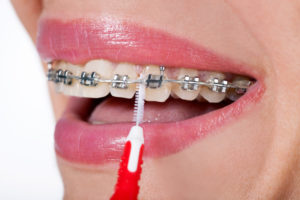
Many problems that come with braces can be avoided or lessened by sticking to a strict oral hygiene regimen. To properly maintain your braces, make sure to brush after every meal, use threadable floss or a floss threader and use a proxabrush. Even though it may seem excessive to brush after each meal, this practice can get rid of remaining food that may be stuck in your braces and prevent plaque and acid from building up (which helps prevent demineralization and gingivitis). Floss threaders are placed between the teeth and under the wire to aid in flossing. Threaders help you floss between each tooth, which can be difficult to do with braces in the way. A proxabrush is typically referred to as a “Christmas tree brush” and helps clean between each bracket. By placing the proxabrush under the archwire and between each bracket, you can thoroughly clean the bracket and remove any stuck food particles.
Maintaining a good diet, especially during orthodontic care, should be another important part of your oral health routine. Sticky or hard foods, such as nuts, popcorn, gum, caramel and chips, can damage your orthodontic appliance and hurt your teeth. Although the temptation may be great to cheat and eat one of these items, the consequence of doing so can be costly and painful. Eating these foods also gives you a higher risk of developing cavities during your time with braces, which can be difficult to treat. Make a list of the foods you should and should not eat, and stick to your oral health goals to keep your teeth and braces healthy.
Starting Orthodontic Care On The Right Foot
If you or a member of your family is in need of orthodontic care, call Belmar Orthodontics at (303) 225-9016! Our dedicated staff is ready to help you achieve your oral health goals and get a beautiful, straight smile. Call now to find out what options we have for braces and how soon you can begin treatment!
Signs That You Might Need Braces
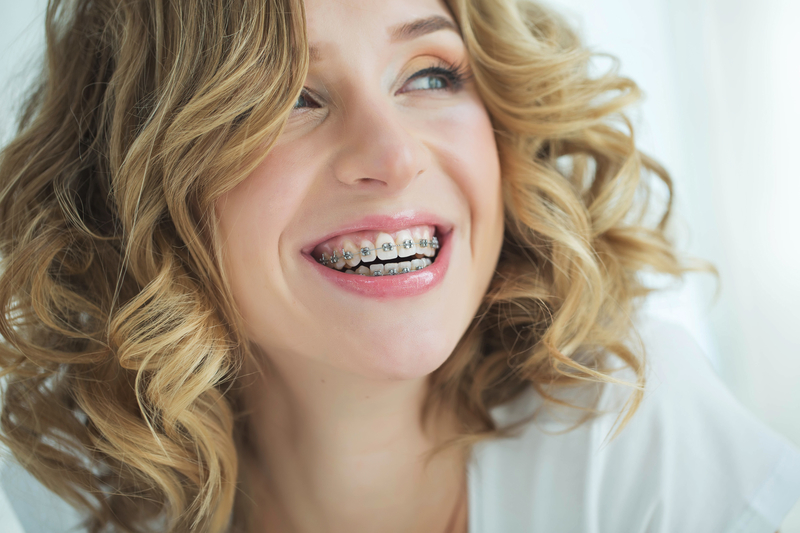
For many patients, getting braces is a big decision that affects oral health. How do you know whether you or your child needs braces, though? Some symptoms are obvious: misplaced or crowded teeth, or teeth that don’t meet normally. Other signs that you need braces are more inconspicuous, though, such as biting the cheek or a jaw that pops or shifts. While some of these symptoms are more serious than others, orthodontic care is the way to go to alleviate pain and correct any underlying issues. Learn about what signs you should be looking for to decide if braces are right for you with these tips!
What To Look Out For
As our teeth begin to erupt at a young age, they can fill into improper spaces or cause problems with adjacent teeth. Crooked or misaligned teeth aesthetically aren’t very pleasing for people, and most patients end up receiving orthodontic treatment during some point in their lives. Orthodontic problems don’t always mean crooked teeth, though. While there are some obvious signs that you might benefit from orthodontics, such as crowded teeth or an underbite/overbite, there are other symptoms that are less noticeable but equally as undesirable. The American Association of Orthodontics recommends that children have their first orthodontic visit between the ages of 7 and 8, but if certain complications are present, your child does not and should not wait until that age to be seen. If you have a young child, look for some of the following symptoms that warrant orthodontic care:
- Thumb or finger sucking
- Early, late or irregular loss of baby teeth
- Difficulty in chewing or biting
As children age, orthodontic problems will begin to show themselves, but some don’t appear until adulthood. No matter your age or prior orthodontic care, there are other symptoms that indicate a problem and should be addressed by an orthodontist. If you are struggling with a popping jaw, have to breathe through your mouth on a regular basis, are constantly biting your cheeks, and/or noticing teeth or jaws that are out of proportion to the rest of your face, you should have an orthodontic consultation. While many of these symptoms seem harmless or aren’t very noticeable, they can have long-term consequences that can negatively affect your oral health. Braces can remedy these issues so that your oral health isn’t compromised. It’s never too late for you to take charge of your oral health and get the smile that you deserve!
Advantages of Early Orthodontics
Not all kids will need orthodontic care, but many will. Meeting with your child’s dentist early on will help them determine whether your child would benefit from orthodontic treatment. If you have a child who needs an orthodontic issue remedied, there are certain advantages that come after receiving braces. Having your child evaluated by an orthodontist can help he/she observe the progress of incoming teeth, guide teeth into their ideal positions, monitor face and jaw development, detect hidden dental issues and reduce the risk of impacted teeth. For young children, orthodontic visits can sometimes be scary. Nonetheless, child orthodontic visits are simple and non-intrusive, so as to keep your child comfortable and happy. At Belmar Orthodontics, we do our best to give your child the care they need while making sure that their fears and questions are addressed. For adolescents, our options at include aesthetically-minded treatment options that will help your teen feel less self-conscious about braces. Braces can sometimes be seen as “dorky” or “uncool” for teens, but the list of options your teenager can choose from will give them plenty of choices to get straight teeth while still looking cool. Good oral health habits are started at a young age, and bringing your child in to see the orthodontist will help them establish those habits that will last a lifetime.
How You Can Benefit From Adult Orthodontics
Against popular belief, braces and orthodontic care aren’t just for kids and teenagers! In fact, one in five orthodontic patients is an adult; in just the U.S. and Canada alone, more than a million orthodontic patients are adults! You, as an adult, can benefit from the same care that young patients do and fix the orthodontic problems that you’ve been suffering from since childhood. As long as your teeth are healthy, you can receive orthodontic treatment at any age. The most common benefits of adult orthodontics include the following:
- More discreet treatment methods
- Correction of lifetime dental issues
- Faster treatment time than previous treatments
- Increased confidence and self-esteem
It’s important to note, however, that any previous orthodontic problems, such as periodontal disease or decayed/missing teeth, will need to be addressed before an orthodontic appliance can be placed. Once those issues are fixed, you’ll be fitted with braces and can continue your life just as usual. If you so choose, you can even opt in for hidden lingual braces or Invisalign clear, which will get you the straight teeth that you want while being completely unnoticeable. Speak with your orthodontist to determine which braces would be best for your needs before making any decisions.
Staying On Top Of Your Oral Health
Before any patient can receive orthodontic treatment, the health of their teeth, gums and mouth will first be evaluated. For this reason, it is important that children and adults alike are brushing twice a day and flossing on a nightly basis. The foods we eat also affects our oral health, as well. Especially during orthodontic treatment, certain foods, like sticky or sugary candies and food, can damage orthodontic appliances and make it easier for tooth decay to develop as plaque builds up on teeth. Brushing and flossing will partly diminish the effects of these foods, but not entirely. Make sure that you and your children are eating a healthy diet with minimal sugary snacks to avoid dental complications during treatment.
To ensure good oral health during and after orthodontic treatment, schedule an appointment with Belmar Orthodontics at (303) 225-9016 for a consultation.
Interesting Facts About Teeth and Dentistry

Our teeth are one of the most important parts of our bodies, and they are each unique to us. Our teeth are like a fingerprint: they are individual to us and never the same as anyone else’s. Teeth perform specific functions that are essential for speaking and eating. Our teeth have enamel, which is the hardest substance in the body and it protects our teeth from decay. The more that we learn about our teeth, the more important it is for us to take care of them. Find out what all our teeth do and how they help us with this guide!
Facts About Dentistry
For hundreds, and even thousands, of years, dentistry has been an important aspect of human’s lives. Even though dental technology and knowledge might not have been as well known a few thousand years ago, our ancestors still understood the importance of taking care of their teeth. People have been caring for their teeth for centuries, and historians have found evidence of dental care dating back to 5000 B.C. in ancient Egypt. The Egyptians would use crushed eggshells and ground animal hooves to clean and polish their teeth, before toothbrushes were invented. The first toothbrushes that were used anciently were actually twigs, or tree bark, that our ancestors would chew on, hoping that the frayed ends would clean their teeth. It wouldn’t be until the 1700s when a British inventor created an adapted version of a toothbrush that he had seen in China, one with a bone handle with boar bristles inserted into small holes that lined the brush and then secured with wire. Even up to the 1930s, toothbrushes were still rudimentary, until brushes with nylon bristles and ergonomic handles were developed, which is what we still use today.
Facts About Teeth
Although oral hygiene was important to our ancestors, little was known about the function and specifics of teeth that modern technology has allowed us to learn about in our day and age. Teeth are the hardest substances in our bodies, and enamel helps keep them strong and durable. We use teeth to eat, speak and chew, so they’re an important part of how we live. Even though they are hard, white and contain calcium, teeth are not bones! They cannot heal themselves or grow back if they sustain damage, so it’s very important that we are careful with what we eat and the activities that we engage in to avoid any unnecessary trauma. Additionally, teeth contain stem cells. Some researchers are even trying to use dental stem cells to regrow human teeth, which, if they can do it, would mean that we could replace lost adult teeth for the first time in history. Not only do teeth have stem cells, but they are also unique to each one of us and tell a story. Each tooth in our mouths is unique and different from the rest, and never is identical to someone else’s. Our teeth reveal how old we are, what we eat and even areas of the world that we have lived in! They are a lasting record of our life’s history.
Our mouths, and the teeth that are found therein, perform amazing functions that facilitate our ability to eat and digest food properly. Although they may be amazing, our mouths have some unusual quirks that most people don’t know about. The following are some of the weird facts about our mouth and teeth that one should think about:
- Teeth form in the womb, months before a child is even born. The crowns of babies’ first 20 teeth are already under the gumline when they are born, waiting to erupt.
- The average human produces 25,000 quarts of saliva in their lifetime, enough to fill two swimming pools.
- Plaque found on teeth contains more than 300 kinds of bacteria.
- Humans spend 38.5 days of their life brushing their teeth.
Good Dental Habits To Have
Now more than any generation before us, we have a limitless amount of options to choose from to protect our oral health and develop strong, healthy teeth. Our teeth do so much for us, so it’s important that we do everything we can to protect them. First and foremost, brushing and flossing should become part of our daily routine. Especially if your or your child has braces or an orthodontic device, maintaining a strict brushing and flossing regimen will prevent tooth decay and cavities. Brushing removes debris on the surface of the tooth while flossing removes food particles that can get stuck between teeth or near the gumline, where plaque can easily build up. Furthermore, regular checkups for both you and your child with your dentist and/or orthodontist will allow them to monitor teeth movement and keep your teeth as shiny and beautiful as possible.
For more information on what you can do to protect your teeth with or without braces, call Belmar Orthodontics at (303) 225-9016! Our dedicated team is committed to helping you and your family receive the care that you need and get the smiles that you deserve!
Why Is Orthodontic Care So Important?

Many patients receive orthodontic care during childhood or early adolescence. As modern technology has advanced, so has the need for orthodontic care in patients of all ages. Whether your symptoms are severe or not, orthodontic care can help monitor face and jaw development, reduce the risk of impacted teeth and correct life-time dental issues. Early detection and treatment are essential for good oral health and maintaining a beautiful smile. No matter what your age is, find out how orthodontic care can benefit you now and what effects it can have on you in the future with this guide!
Benefits of Orthodontics
Just like any other product you buy or activity that you participate in, orthodontics is an investment. It is an investment of time, money and patience, but the results can be life-changing. There are a variety of options to choose from when receiving orthodontic care, and many are so discreet that you hardly even notice that they’re there. Orthodontic treatment helps establish good oral health and can pave the way for a healthy smile now and in the future. A healthy bite and a good-looking smile is just as important at age 60 as it is at 16, and orthodontic treatment is the way that you can ensure that you have both. For kids, some benefits of early orthodontics include:
- Observe the progress of incoming teeth
- Guide teeth into their ideal positions
- Monitor face and jaw development
- Reduce the risk of impacted teeth
- Detect hidden dental issues
As technological advances in dental science has improved, there are more options than ever for adults seeking orthodontic treatment. Many times, adults have been struggling with specific orthodontic issues since childhood that have never been resolved, but orthodontic care can fix that. Even though orthodontic treatment is most successful during adolescence as teeth and jaw bones are still developing, adults can still enjoy improvements to their oral health with orthodontic treatment at any age. Whether it be traditional metal brackets or other discreet options, like Invisalign, there are plenty of ways to straighten teeth. Some of the many benefits that adult orthodontics provide include:
- Faster treatment time than former orthodontic techniques
- Correction of life-time dental problems
- More discreet treatment methods
- Increased self-esteem and confidence
When To See An Orthodontist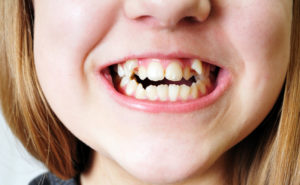
The American Association of Orthodontics recommends that children have their first orthodontic visit by age 7 or 8 to prevent the progression of any orthodontic issues that may be present. Even if you do not detect any dental issues with your child, it is still important that they get evaluated early on so that their teeth and jaw development can be properly monitored. If you notice that your child has bite problems or protruding teeth, it is time for them to see an orthodontist. Bite problems, such as a crossbite, cause the jaws to develop unevenly, while protruding teeth can be fractured or injured much easier than normal teeth. For both children and adults, there are certain signs that you should look out for that may necessitate an orthodontic visit. Some of these symptoms include difficulty chewing or biting, jaws that shift or make sounds, grinding/clenching teeth, biting the cheek or roof of the mouth, protruding teeth, and facial imbalance or asymmetry (facial features out of proportion). Even oral habits, such as thumb-sucking, affect how the mouth develops and can necessitate orthodontic treatment. For many patients, orthodontic treatment isn’t necessarily needed but is wanted to improve self-confidence and give them a prettier smile. Whatever your reason is, orthodontic care can help you reach your goals and improve your oral health at any stage in life.
How You Can Start
After you make the decision to begin orthodontic treatment for yourself or your child, the first thing to do is schedule an appointment with your orthodontist for a consultation. This consultation will allow both of you to establish appropriate goals, address concerns and develop a treatment plan. Additionally, taking good care of your teeth at home by maintaining an oral health regimen is important to keep your teeth healthy and prepare them for orthodontic treatment. Consistent brushing and flossing each day will protect your teeth and gums from plaque, tooth decay and cavities. During orthodontic treatment, it’s essential to maintain this routine to avoid any complications from occurring, which can extend treatment time and be costly to fix.
If you have questions regarding orthodontic treatment for yourself or your child, call Belmar Orthodontics at (303) 225-9016! Our talented staff is dedicated to you and your oral health goals, and will strive to help you get the beautiful smile that you deserve!
Whitening Teeth With Braces
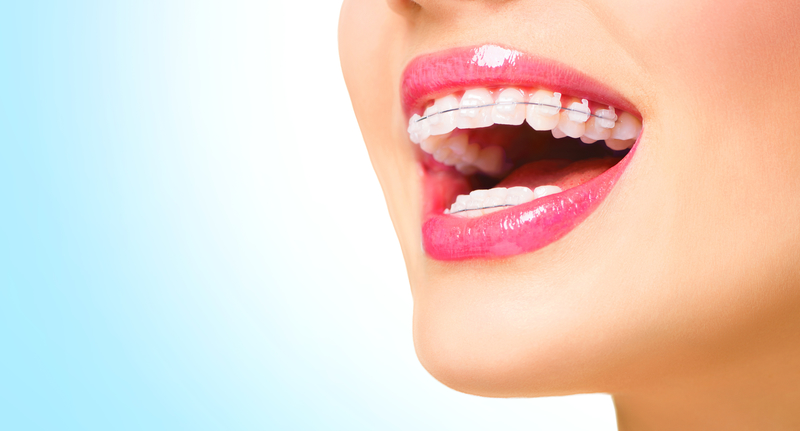
Keeping teeth clean during braces is an important part of your oral health regimen, but keeping teeth white with braces sometimes presents a problem. Teeth whitening with braces is a common practice that orthodontic patients have done to keep their teeth white during orthodontic care. Which teeth whitening treatment you use will depend on what type of braces you have. Achieving a whiter smile is not impossible with braces, but will need extra effort and care to protect your braces. Find out how you can both whiten and straighten your teeth at the same time with these tips and tricks!
In-Office versus At-Home Treatments
Teeth whitening has been a popular choice of treatment for dental patients for years now, but orthodontic patients can now receive the same treatment, too, while getting their teeth straightened at the same time. Keeping your teeth clean while undergoing orthodontic treatment is an important step in maintaining good oral health, and teeth whitening options can enhance that process. With the variety of treatment options that orthodontic patients now have to straighten their teeth, there are plenty of ways to whiten teeth while receiving care. For patients who prefer whitening their teeth at the dental office, one option that patients can choose is “chairside bleaching.” This process requires one or two office visits in which a strong bleaching agent is applied to the teeth combined with a special light to accelerate the whitening effect and lift stains. For patients with brackets on the front of their teeth, chairside bleaching can cause a two-tone effect after traditional braces are removed, so sometimes it is best to bleach after your treatment is over. For patients with lingual braces (on the backside of teeth), though, it is relatively easy to whiten teeth during treatment since teeth whitening focuses on the front of the teeth and not the back. Removable braces and retainers also allow for successful teeth whitening as they allow all of the teeth to be uncovered.
Many patients prefer at-home teeth whitening treatments over in-office treatments because it allows them the flexibility to decide when and where they whiten their teeth. For at-home treatments, gel similar to those used in dental offices will be given to you that is inserted into a customized tray which is fit to your mouth. The gel uses peroxide to bleach the tooth enamel and whiten the tooth. Even those with braces can use these custom trays after braces have been placed in the mouth. The trays have to account for the space that brackets use so the gel doesn’t displace the bracket from the tooth. With at-home treatments, though, there is a larger risk of sensitivity and gum irritation if bleaching material leaks out of the tray. Both options for teeth whitening allow patients the freedom to get the best results during their orthodontic treatment but still get the same benefits that braces offer.
Things To Consider
When deciding on which type of teeth whitening you should do, it is important to remember that the type of braces you have dictates what kind of teeth whitening you can receive. As teeth shift during orthodontic treatment, tooth sensitivity and gum irritation can increase when using mouth trays or teeth whitening strips at home. Traditional braces use brackets on the front side of the teeth to correct malocclusion while other options, like lingual braces, use brackets on the backside of teeth to straighten teeth. Whitening teeth with lingual or removable braces is much easier for patients than those with traditional braces as brackets prevent a good portion of the tooth from bleaching agents. For this reason, most orthodontists recommend using teeth whitening products once braces are removed for most effectiveness. If you do choose to use teeth whitener during treatment with traditional braces and you feel some sensitivity/tenderness, make sure to avoid whitening for a while to give your teeth a break. Chewing gum can also help with any pain you might feel from whitening agents, as well as using sensitivity toothpaste. For additional insights into what to expect when using teeth whitener with braces, meet with your orthodontist to discuss which option is best for your mouth.
Everyday Teeth Whitening
Many patients use everyday teeth whitening products to improve their smile rather than going to a dental office or using expensive products. As teeth whitening has become more popular, more and more products have been created to enhance smiles in the comfort of one’s home with a smaller price tag than traditional methods. For anyone, with or without braces, using a teeth whitening toothpaste is a great and easy way to whiten your smile and maintain good oral health at the same time. Even if you have sensitive teeth, there are still plenty of options for toothpaste that whiten teeth without putting your sensitive mouth at risk. There is also teeth whitening mouthwash that whitens and protects teeth from stains while freshening your breath at the same time. Switching from a manual to electric toothbrush can further whiten your teeth by polishing away surface stains that appear under braces. With all of the different dental items that can be tailored to your individual needs, you can have a whiter smile with braces in no time.
For more information on how you can whiten your teeth during orthodontic treatment, call Belmar Orthodontics at (303) 225-9016! Our team is committed to helping you and your family get the healthiest and brightest smile possible!
Is It Too Late For Me To Get Braces?

Most orthodontic patients receive their braces at a young age, typically during the teenage years. Are the teenage years the best time to receive braces, or will treatment work just as well as an adult? With the technological advances that have occurred, adult orthodontics have more options than ever to straighten smiles of all ages. Some benefits of adult orthodontics include correction of life-time dental issues, faster treatment time than former technology, and increased confidence. If you’re ready to change your smile, learn how adult orthodontics can help you through these tips!
Braces Throughout The Years
Modern advances in orthodontic treatment has revolutionized how quickly children and adults alike get the healthy and straight smiles they want, and allowed people of all ages to improve their oral health, no matter their age. For many years, traditional metal brackets were the only option to straighten teeth, but as technology has advanced, a variety of aesthetic bracket systems have been developed to give you the smile you want with braces that are less noticeable and easier to maintain. Permanent braces now come in two options: metal or ceramic. Ceramic braces are matched to teeth color, making them nearly invisible during treatment. Lingual braces are also an option, which are completely disguised from others as they are attached to the back of the teeth. Removable orthodontic appliances have recently come into play as a clear plastic aligner that is used and removed as needed. These aligners are advantageous to adults because they are less visible and easier to clean and maintain, which comes in handy for those adults busy with work and family life. As the options for braces have broadened throughout the years, so has the number of adult patients being treated for braces. Technological advances in the orthodontic industry now allows for more patients, even those who have passed the prime age for orthodontic care, to change their smiles during any part of life.
Benefits of Adult Orthodontics
The American Association of Orthodontists reports that of the 4.5 million Americans that are currently receiving orthodontic care, 25% of them are adults. Although childhood is the ideal time to receive braces, adult orthodontics has become a popular option for those who couldn’t receive treatment during adolescence. Some benefits of adult orthodontics include:
- More discreet treatment methods
- Correction of lifetime dental issues
- Faster treatment time
- Increased self-esteem and confidence
Adults ultimately have more options when choosing what braces and treatment plan is best for them. Orthodontic care protects both kids and adults against tooth decay, tooth loss, gum disease, impaired speech, chewing and jaw problems. While cost is a factor, you will still need an oral evaluation and orthodontics consultation to determine your candidacy for certain procedures and treatments. For the first time, adults of any age who have otherwise healthy teeth can benefit from orthodontic treatment at any point in life.
What To Expect With Adult Orthodontics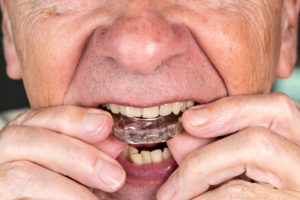
Typically, it is more difficult to manipulate an adult’s fully-developed jawbone compared to the pliable jawbone of a child, but modern-day advances now allow orthodontists to correct crooked teeth with great success and precision. Any oral health issues, such as periodontal (gum) disease, will have to be resolved before teeth can be straightened, so meeting with your dentist and orthodontist will be an important first step to take before treatment can begin. If you’re considering orthodontic treatment to correct any cosmetic or bite issues, consider the following:
- The entire process may take longer for an adult than a child. Typical treatment time averages two years, but varies from person to person.
- Fully-developed bones in adults have stopped growing, so some structural changes cannot be achieved without surgery.
- Adults may need to see a periodontist, as well as a dentist and orthodontist, to ensure that treatment will not be complicated by bone loss due to gum disease.
Adults who have had teeth removed in the past might have difficulties with orthodontic care as old extraction sites might not be suitable for teeth to move into. Adult patients receiving treatment also have a higher risk for root absorption than children do as their bodies reabsorb the root of the tooth, leaving no room for anchorage. This process causes teeth to loosen and fall out over time due to gum instability. Since braces and other appliances are cemented directly to the teeth themselves, it is important that all patients, even adults, maintain good oral health practices that will prevent the areas around the brackets from developing plaque and tooth decay, which will ensure that they get the best (and healthiest) smile possible.
Schedule An Appointment Today
If you are interested in adult orthodontics or are wanting to improve the look of your smile, call Belmar Orthodontics at (303) 225-9016 for a consultation to learn about which options are available for you. Our dedicated team of professionals are determined to help you get the smile that you want and improve your oral health!
Temporary Anchorage Devices: What Are They?
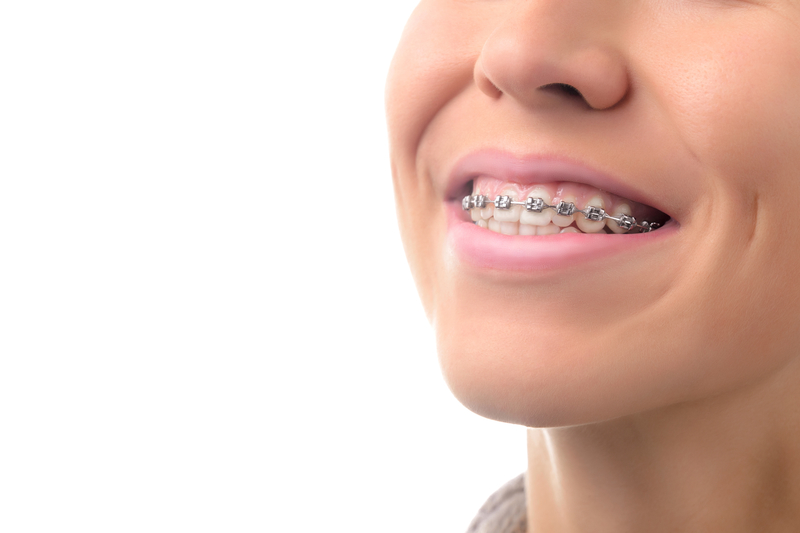
Whenever our teeth need an extra push to shift them into a straighter position, orthodontists will typically install a temporary anchorage device, commonly known as a “TAD.” Although they’re not used in every case, they help pull, push, and lift difficult to adjust teeth into the correct position. If your orthodontist recommends that you have a TAD, read through this guide to understand how they function and what you can do to maintain them!
Origins of Orthodontia
Poorly aligned jaws and teeth have been a nuisance to mankind since the beginning of time, so it’s no surprise that orthodontics has been around for so long. Archaeologists have found human remains with crooked teeth dating back 50,000 years; interestingly enough, the remains of some ancient civilizations, like Egypt, have been found with crude metal bands around their teeth, a form of orthodontics very similar to braces that we see nowadays. The ancient Greek, the Etruscans, and the Romans also practiced orthodontia and kept records of their discoveries. The ancient Greek physician, Hippocrates, was the first to describe teeth irregularities around 400 BC, and centuries later, Celcus would advise bringing newly emerging teeth into their proper position by pushing them with your fingers.
By the 1700 and 1800s, orthodontics was developing rapidly. Pierre Fauchard, the “Father of Dentistry,” would create the bandeau that allowed teeth to align correctly by using a strip of metal with regularly spaced holes that fit around the teeth. During the 20th century, Edward Hartley Angle would identify the true properties of a malocclusion, or misalignment, and begin addressing them with an effective set of orthodontic appliances that were developed much earlier. By the 1970s, braces would further advance through the invention of dental adhesives that would allow orthodontists to stick brackets to teeth surfaces rather than wiring them around each tooth. Stainless steel replaced gold and silver that were previously used as the wire, which helped reduce the cost of braces significantly. Even with the impressive advances that we have made since the beginning of orthodontics, patients around the world still suffer from advanced teeth and jaw malocclusion that normal braces can’t resolve on their own. For the purpose of increasing the effectiveness of braces, other orthodontic devices have been invented to facilitate this process.
Orthodontic Devices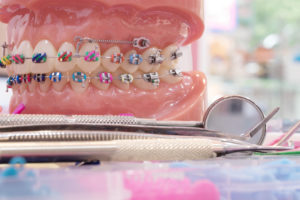
Whenever we think of “orthodontics,” we innately assume braces. Braces have two basic parts: brackets and wires. Wires move the teeth and brackets serve as a stationary holder for the wires. Contemporary braces can be stainless steel, gold-colored, or tooth-colored ceramic. Most braces go on the front of the teeth, but there are some, called lingual braces, that are fastened onto the backs of teeth that are virtually invisible. Lingual braces are not the same as clear aligners, which is another orthodontic device. Clear aligners are made of a transparent plastic-like material and are considered “invisible braces.” They are made to fit the patient’s teeth at different stages of treatment. Each set of aligners is worn for 1-3 weeks for at least 22 hours a day, and are designed to move the teeth incrementally until the next set is used. While these types of braces are a very common sight to see in many homes, schools, and workplaces, they aren’t the only devices used to move teeth and align jaws. Power chains are sometimes used with braces for an added push. They are stronger than the traditional elastic rings and can apply an extra force when needed. The last orthodontic device that is commonly used, although many patients don’t know what their purpose is, is a temporary anchorage device, or TAD.
TADs
Temporary anchorage devices, most commonly known as TADs, are used in some orthodontic cases to help shift the teeth into a straighter position when traditional braces can’t do it on their own. For this reason, not everyone needs them. TADS use titanium mini-screws (sometimes called mini-implants or micro-implants) that provide a fixed object that can be used to push, pull, lift, or intrude teeth that are being straightened. TADS don’t move and can be placed in many different parts of the mouth, so they are highly efficient at moving difficult teeth back into proper alignment. Before TADs are ever inserted into your mouth, though, your orthodontist will evaluate your teeth and determine whether your malocclusion is severe enough to receive a TAD. Before insertion, your gum tissue and jaw area will be numbed so that the procedure will be nearly painless. The TAD is then placed into your jawbone, and will eventually be removed once your orthodontist feels that it is no longer needed for straightening your teeth.
Just like braces, it may take a couple of days for the discomfort to subside and your mouth to get used to the TAD. Try taking an over-the-counter pain relief medication to alleviate any excessive discomfort. An important part of maintaining your TAD is continuing your oral hygiene regimen. Continue to brush your teeth at least twice a day and use mouthwash with antimicrobial ingredients. As long as your gums are healthy throughout the duration of your treatment, you shouldn’t have any complications with your TAD.
Get Straighter Teeth Today
To learn more about TADS, or to schedule an appointment to begin your treatment plan for braces, call Belmar Orthodontics at (303) 225-9016! At Belmar Orthodontics, we have a highly skilled and experienced team that is happy to help you start your journey to a healthier and happier smile.
Choosing A Good Toothbrush
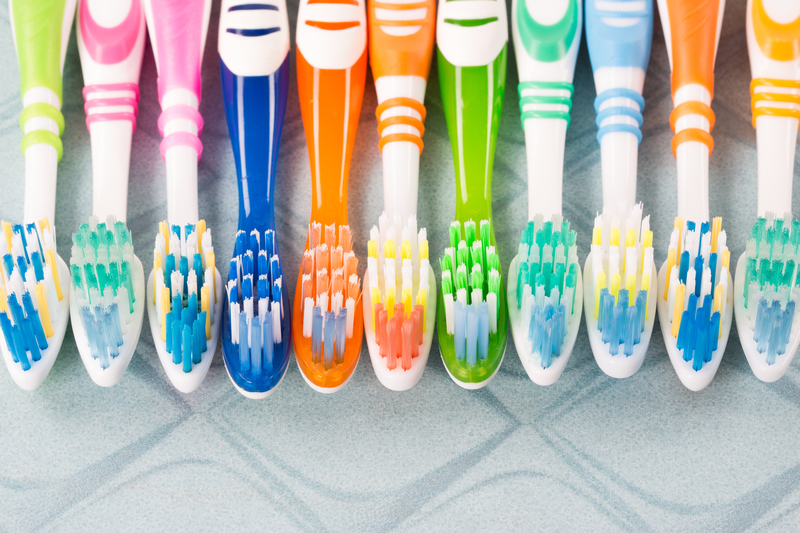
Do you ever look at all the toothbrush options at the store and wonder what the difference is between all of them? Toothbrushes come in all shapes and sizes, and it’s for a reason. They are made to fit certain sizes of mouth. Bristles come in various materials and designs, and there are extra features on some toothbrushes. So what should you choose? Use these tips for the next time you pick out your toothbrush so you know you’re getting a good one for your mouth!
Why So Many Different Kinds?
For something that is so simple to use, there sure are a lot of different toothbrushes out there. Toothbrushes have been around for centuries, with some historians quoting them as being as old as 3000 BC! Ancient civilizations used a “chew stick,” or a twig that had a frayed end in which they would brush their teeth. The common bristled toothbrushes that we are so familiar with didn’t come into existence until around 1498 in China. The bristles that were used in these toothbrushes were actually hog hair that were attached to handles made of bamboo or bone. Even these evolved, though, into the toothbrushes that we use today, but instead with nylon bristles and plastic handles.
Since World War II, oral health has increased in popularity and a variety of different toothbrushes have been invented. But which ones are best? How do you know which toothbrush is for you? Toothbrushes are specifically designed for different sizes and shapes of mouths, plus there are age-specific toothbrushes, like for children, that have smaller (or larger) handles and bristles depending on the age of the person. No matter what toothbrush you use, the principle behind it should be the same: improve your oral health care and prevent disease. Your toothbrush should be helping you do that, if you’re using the right one.
Types of Toothbrushes
There are basically two types of toothbrushes: soft-bristled and hard-bristled. Most dental professionals agree that using a soft-bristled toothbrush is best for cleaning plaque and debris on your teeth. Hard-bristled toothbrushes are not recommended as they are known to wear away your enamel and can lead to gum recession and lesions. Although they do remove more plaque than traditional soft-bristled toothbrushes, hard-bristles cause more damage than good, even when trying to get rid of tough plaque. Toothbrushes with small heads are also great to use because they can get into the hard-to-reach places in your mouth. When deciding between a small-headed or large-headed toothbrush, keep in mind that the size of your mouth should be the determinant for which one you buy. Those people with large mouths should use a full-sized toothbrush head, while those with smaller mouths should utilize a more compact head.
Toothbrushes also vary in the type of the handle (non-slip grip or flexible neck), shape of the head (tapered or rectangular), and style of bristles (rippled, flat, or dome shape). Although there are a variety of kinds, ultimately the best toothbrush is one that fits your mouth and allows you to reach all of your teeth easily. To figure out which one works best for you, trying toothbrushes with different bristle styles or head shapes is recommended until you find one that is most comfortable.
Manual or Electric: Which is Better?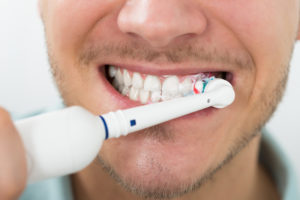
With the advent of the electric toothbrush, many people have been drawn to its ease of use and effectiveness. While manual toothbrushes have been used for centuries, the electric toothbrush is faster and more efficient. If you’re a diligent brusher, manual toothbrushes are a great option, but for those who want the toothbrush to do the work for them, electric is the way to go. Just like manual toothbrushes, electric toothbrushes come in different sizes and have a variety of replaceable heads. Electric toothbrushes are known for having smaller heads than manual, so at the beginning, it may take some time getting used to their small size.
Because of their size, electric toothbrushes are able to clean teeth more thoroughly and get to hard-to-reach areas of the mouth better than manual toothbrushes can. Electric toothbrushes also use different types of bristles movements, such as oscillating/rotating technology, that has been proven to remove more bacteria and plaque than manual toothbrushes. Additionally, electric toothbrushes have a smaller likelihood of hurting your enamel and gums, which is advantageous for those individuals who have sensitive teeth and gums. Whether you choose manual or electric, the most important takeaway is that both fit your mouth size and allow you to clean each individual tooth. If your toothbrush can do both of those things, you’re on your way to achieving great oral health and a nicer smile.
Tips For A Cleaner Mouth
Having the correct toothbrush for your mouth is the first step in maintaining good oral health. But a common question that many have is, “What is the correct way to brush my teeth?” When using a regular soft brush, make sure to angle the brush along the gum line and brush down from the top, then up from the bottom on each tooth in small circles. This motion helps get out the tiny food particles stuck between your teeth, plus it protects your gums from over-brushing. If your gums tend to bleed when brushing, that usually indicates that the gums are inflamed and those areas should actually be brushed more thoroughly and more often. Also make sure that you are brushing your chewing surfaces, the inside of your teeth, and your tongue.
For more tips on how to protect your teeth and maintain a healthier mouth, visit your local provider at Belmar Orthodontics. Change your oral health for the better by calling (303) 225-9016 and setting up your first consult for the comfort, care, and personalized treatment that you deserve!

